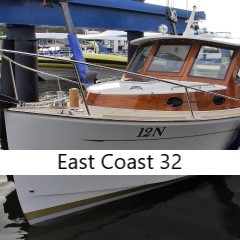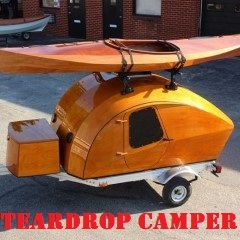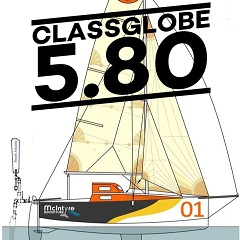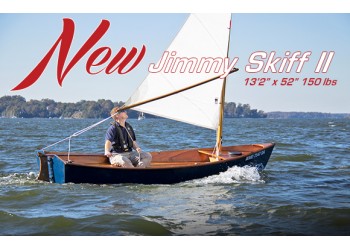Jimmy Skiff II
Availability: Made to Order (approx. 6 weeks)
Ex Tax: See options for price
The original Jimmy Skiff was launched by Chesapeake Light Craft in 1998. An immediate success, this straightforward 13-foot skiff has remained popular for twenty years.
|
||||||||||||||||||
Designer John C. Harris has been working on a clean-sheet redesign since 2012. The prototype was launched in 2017 and was in testing for 18 months.
The Jimmy Skiff II is the same length as its predecessor and only an inch or two wider, but it's a higher-volume, stiffer boat. Here are the main differences:
1. The hull shape and the transom have been modified to allow easy and safe use of a small outboard engine. (2-3hp is plenty.) The original Jimmy Skiff had no provision for an engine at all.
2. The interior of the Jimmy Skiff II is "tanked in." In other words, a lot of flotation is built into the hull in the form of comfortable bench seats. This makes the boat easy to right from a capsize. The flotation also conforms to US Coast Guard regulations for positive buoyancy, allowing the Jimmy Skiff II to carry an engine.
3. You sit on bench seats while sailing, instead of on the floor!
4. The sailing rig is 15% larger, and more powerful.
Those looking for a super-versatile utility skiff will be hard-pressed to find a better design. The Jimmy Skiff II rows beautifully, sails fast on all points, and handles great with an outboard engine.
Payload is 500-550lbs.
Computer-cut kits feature all of the latest tweaks to allow construction by first-timers, including slot-together frames, pre-drilled holes for stitching-and-gluing, puzzle joints, and Ikea-like precision in the fitting of parts.
Build this boat if:
You want a boat for days of family fun on the water.
You want a stable, lightweight craft for fishing or gunkholing.
You want a comfortable day sailer that rows well and can be fitted with an engine.
You want a nifty sail trainer.
Frequently Asked Questions
How much does the Jimmy Skiff weigh?
The designed weight is 120 pounds (54 kg). Most builders will finish between 120 and 130 pounds (60 kg).
What is the Jimmy Skiff's payload?
525 lbs (238 kg). When sailing, payload is limited to 500 lbs (227 kg).
What are the differences between the original Jimmy Skiff and the new one?
While both boats are 13-foot (3.96 m), flat-bottomed skiffs, the designs have considerable differences. The Jimmy Skiff MK II has a long, open cockpit with longitudinal flotation tanks for seats, a bit less rocker than the original in the hull, a stronger transom that will handle an outboard engine, a slightly fuller bow, a taller mast, and a larger 68 square foot (6.32 sq m) "leg-o-mutton" sail. The daggerboard trunk is offset into the starboard seat in order to maintain a long, open cockpit. The new Jimmy Skiff II requires two more sheets of plywood than the original, resulting in a boat that is slightly heavier, but considerably stronger than the original design.
How big an engine can I use?
The Jimmy Skiff is not designed to operate at high speeds under power. A 2 or 3 hp outboard will power the Jimmy Skiff to around 6 knots with two adults and a child on board; any more power is unnecessary and potentially dangerous. 40 pounds (18 kg) of engine weight is the maximum allowed, but the boat will move more efficiently and comfortably with less weight hanging on the transom. Two stroke engines give the best power-to-weight ratio, but are less environmentally friendly than modern four stroke engines. A 30-lb to 50-lb thrust electric trolling motor is an excellent option.
Short or long shaft engine?
The transom is designed for a short-shaft (15" or 38 cm) engine.
Can two people row in tandem?
No. The two rowing stations are meant to accommodate multiple seating options. For solo trips, you'll row from the midships station. With passengers sitting aft, you'll move the seat forward and row from the optional forward oarlocks to balance the boat. Adjustable rowing seats span the cockpit.
What sort of trailer do I need for the Jimmy Skiff?
The smallest of boat trailers will do. CLC tow theirs on the Trailex SUT-250-SCLC, a lightweight, aluminum trailer.
What are the plans and manual like if I want to build from scratch instead of from a kit?
Plans include full-sized patterns for every part in the boat, including parts for the sailing rig option. The manual includes hundreds of step-by-step color photos and diagrams covering the entire build process, including scarfing plywood.
Can you send me the plans digitally?
Sorry, until digital rights management technology for marine architectural work catches up to books and music, we are unable to transmit digital data, only paper plans and manuals.
Can I build the rowing version first and add the sail kit later?
Yes. The Base Kit includes the daggerboard trunk and mast deck cut-out, as these are integral structural members of the Jimmy Skiff II. Converting to sail means adding a mast step, mast partner, daggerboard, rudder, tiller, mast, spar, sail, and rigging. These components can be added at any future time, even the daggerboard trunk.
How skilled do I need to be to build my own Jimmy Skiff?
Patient first-time boatbuilders who have some experience with epoxy and fiberglass can easily manage a Jimmy Skiff, especially working from a CLC kit. We have gone to tremendous lengths to simplify assembly without compromising the boat's appearance or function.
How long will it take to build the Jimmy Skiff?
Budget around 120 hours for the boat and 150 hours of hands-on time for a completely outfitted sailing version.
Can the Jimmy Skiff be kept in davits?
Sure, on a large enough boat or dock. If you plan to use davits or a mechanical hoist you should install backing plates and hardware in the forward bulkhead and/or seat sides before installing the forward deck or seat tops. Install a drain plug in the hull bottom and keep it open while the boat is hanging high and dry to prevent the hull from filling with water.
How does the Jimmy Skiff tow behind a bigger boat?
With the large, deep skeg and a properly located bow eye, the Jimmy Skiff is well balanced and tracks well under tow.




















